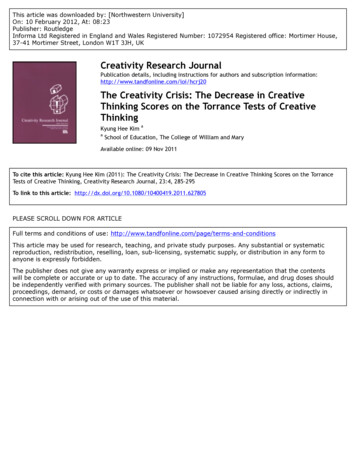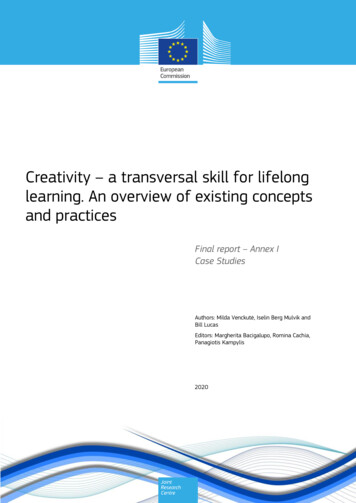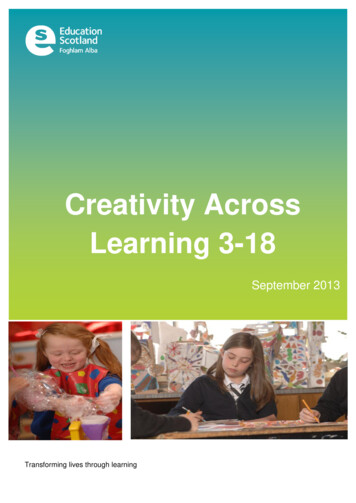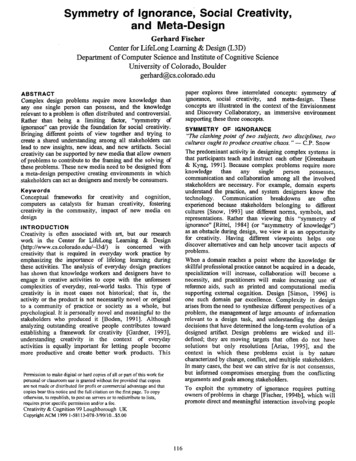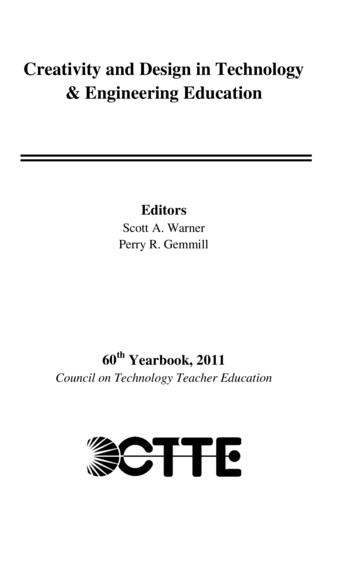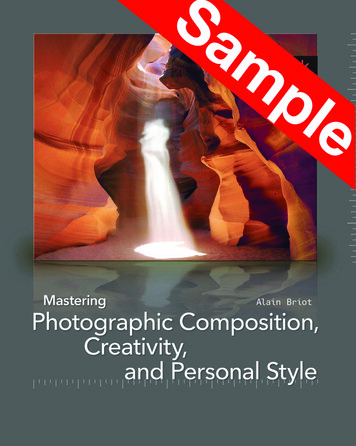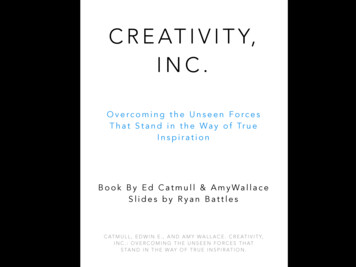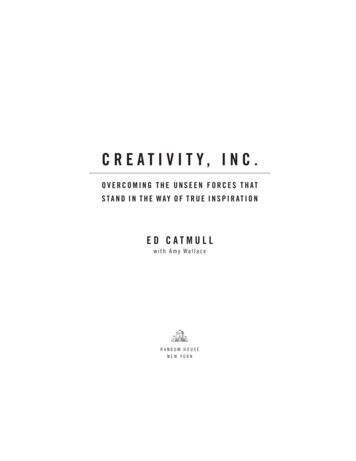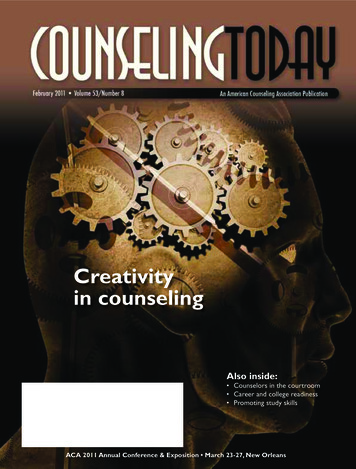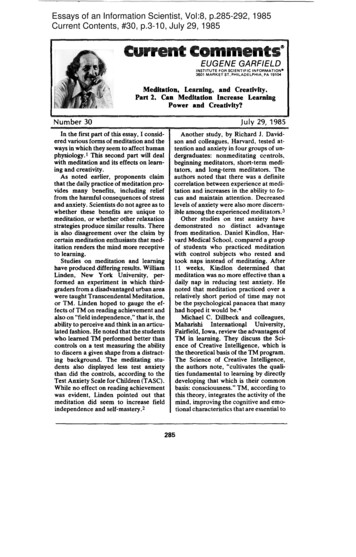
Transcription
Essays of an Information Scientist, Vol:8, p.285-292, 1985Current Contents, #30, p.3-10, July 29, 1985Current Comm*n@s@EUGENE GARFIELDINSTITUTE FOR SCIENTIFIC INFORMATION*3501 MARKET ST. PHILADELPHIA, PA 19104Meditation,Learning,adCreativity.Part 2. Can MeditationIncreaseLearningPowerand Creativity?Number30jUty 29, 1985In the first part of th essay, I considered various forms of meditation and theways in which they seem to affect humanphysiology. 1 This second part will dealwith medhation and its effects on learning and creativity.As noted earlier, proponentsclaimthat the daily practice of meditation provides many benefits,includlngrelieffrom the harmful consequences of stressand anxiety. Scientists do not agree as towhether these benefits are unique tomeditation, or whether other relaxationstrategies produce similar results. Thereis also disagreementover the claim bycertain medhation enthusiasts that meditation renders the mind more receptiveto learning.Studies on meditationand learninghave produced dtifenng results. WilliamLinden,New York University,performed an experiment in wldch thirdgraders from a disadvantaged urban areawere taught TranscendentalMeditation,or TM. Linden hoped to gauge the effects of TM on reading achievement andalso on “field independence,”that is, theabilh y to perceive and think in an articulated fashion. He noted that the studentswho learned TM performed better thancontrols on a test measuring the abilityto discern a given shape from a distracting background.The medhatingstudents also displayed less test anxietythan dld the controls, according to theTest Anxiety Scale for Children (TASC).Whfle no effect on reading achievementwas evident, Linden pointed out thatmedhationdld seem to increase fieldindependenceand self-mastery. zAnother study, by Richard J. Davidson and colleagues, Harvard, tested attention and anxiety in four groups of undergraduates:nonmeditatingccntrols,beginning meditators, short-term medhtators, and long-term meditators.Theauthors noted that there was a definitecorrelation between experience at meditation and increases in the ability to focus and maintain attention.Decreasedlevels of anxiety were also more discernible among the experienced meditators.sOther studies on test anxiety havedemonstratedno distinctadvantagefrom medhation.Daniel KindIon, Harvard Medical School, compared a groupof students who practicedmeditationwith control subjects who rested andtook naps instead of meditating. After11 weeks, Kindlondeterminedthatmeditation was no more effective than adaily nap in reducing test anxiety. Henoted that meditation practiced over arelatively short period of time may notbe the psychological panacea that manyhad hoped it would be.qMichael C. Dillbeck and d, Iowa, review the advantages ofTM in learning, They d cuss the Science of Creative Intelligence,which isthe theoretical basis of the TM program.The Science of Creative Intelligence,the authors note, “cultivates the qualities fundamental to learning by directlydeveloping that which is their commonbasis: consciousness.” TM, according tothis theory, integrates the activity of themind, improving the cognitive and em tional characteristicsthat are essential to285
the process of learning. The authors alsoclaim that TM reduces anxiety, and, further, that anxiety is a major impedimentto Ieaming.sArthur Aron, then of Maharishi International University, and colleagues attempted to measure meditation’s effectson academic performance. They studiedthe frost graduating class at the university, where TM is an integral part of thecurriculum. After testing 15 students atthe start of their freshman year (1973)and again after their senior year (1977),the authors noted increases on measuresof general intelligence and also positivepersonality changes, such as increasedself-confidence.The authors concededthat their study was flawed by the smaflsample size and the lack of a controlgroup.bIn the opinion of some critics, suchflaws are common in studies that presentfavorable results on the effects of meditation, particularlyTM. Kindlon, forone, refers to meditation research as “anarea fraught with special interest.” In atelephone interview, he expressed theview that, in some studies, researcherscommit serious methodologicalerrors,such as failing to assign subjects randomly to treatment or control groups orfailing to provide for any kind of methodological control. Another major flaw,according to David S. Holmes, University of Kansas, Lawrence, involves statistical analysis of data. When researchersstudy such measures as somatic arousalthey often fail to take into account theinitial differencesbetween meditatingand nonmeditatingsubjects. These initial differences,according to Holmes,cansignificantlyaffectsubsequentscores and make results unreliable. TDavid C. Zuroff and J. Conrad Schwarz,University of Connecticut,Storrs, pointout three “pervasive” flaws in TM studies: failure to obtain initially equivalenttreatmentand control groups throughrandom assignment of subjects, an excessive reliance on self-report measures,and the failure to use placebo treatmentsto control for nonspecific treatment effects,s286In another study on meditation andlearning, Carmen J. Carsello and JamesW. Creaser, University of Illinois at Chicago Circle, studied 70 students who hadundergone TM training but who werenot necessarily practicing TM. A controlgroup received no training. Comparinggrade point averages for periods beforeand after meditation instruction, the authors found no significant effects ongrades for the meditators. The authorspointed out that their sample may havebeen slightly ddferentfrom those inother studies, in which subjects tend tohave a positive attitude about meditation. Indeed, Carsello and Creaser notedthat many of the students in their studywere not particularly enthusiastic aboutTM. Thus, any placebo or group-expectation effects may have been negated.These authors expressed doubt that TMis a surefire means to higher grades,although they did not dispute the claimthat it may help some students.gMartin S. Fiebert and Travis M. Mead,California State University, Long Beach,studied two randomly selected groups ofstudents. One group was taught a formof meditation known as Actualism, consisting of a set of techniques for increasing awareness and controlling and directing energy throughout the mind andbody. This group was instructed to practice Actuafism before exams. A controlgroup also learned thk form of medhation, but its members were asked topractice at other times. Both groupskept careful track of the amount of timespent on studying. Performances on academic tests were measured twice: in abaseline phase prior to meditation training and in an experimentalphase aftertraining was completed. The researchersfound no difference between the twogroups on performancein the baselineperiod.In the experimentalphase,however, they noted that the group thatmeditated before tests performed betterthan did the control group. Study time&ld not account for thk dtiference. Theauthors concluded that the practice ofmeditation prior to exams had a positiveef feet on performance. 10
During the 1970s, some school systems in the US included TM in their curricula. Francis Driscoll, for example,superintendentof schools in Eastchester, New York, succeeded in having TMinstructionmade available to alf students and faculty members in h schoold trict in 1971. He noted that the program was a great success in improvingscholastic performance and social interaction and also in decreasing drug use. IiStudies on medhation and drug abuse,however, have produced mixed results.Herbert Benson and Robert K. Wallace,Harvard, whose work on meditation andphysiology was discussed in the first partof this essay, also examined TMs effecton drug use. Using a self-report questionnaire,they surveyedmore than1,800 people who had undergone TMtraining. The subjects ranged in agefrom 14 to 78 years old, although halfwere between the ages of 19 and 23. Results suggestedthat meditationwashighly effective in decreasing drug andalcohol abuse. 12 But such results havenot been entirely consistent. Zuroff andSchwarz randomly assigned 60 undergraduates to three groups. One grouplearned TM, while another received instruction in a muscle relaxation technique. The third group received notreatment. The authors determined thatwhale TM seemed to decrease self-reported anxiety, it had no effect on frequency of drug or alcohol use. Theyconcluded that TM had been “oversold”as a psychological cure-allaThe disagreement over TM in schoolshas spilled into judicial circles as well.David Schimmei, an attorney and professor of education, University of Massachusetts, Amherst, writes of two casesfrom the mid- 1970s involving meditationand the volatile issue of prayer in publicschools. In one case, a federal judgeupheld a Massachusetts law that allowedfor a minute of silence “for meditation orprayer.” The judge ruled that the purpose of the law was not strictly religiousand that the law did not require studentsto pray or meditate and did not constitute a state endorsement of religion. 13In287another federal case, a New Jersey courtruled that TM instructionin publicschools did violate the constitutionallymandatedseparationof church andstate. The controversy centered on thepuja, the brief, tradhionalceremonymarking the beginning of TM instruction. The ceremony involves the burningof candles and incense and chanting inSanskrit by the instructors.The puja,according to instructors,serves merelyto preserve tradhion and is not intendedto have religious sign lcance. However,because the chant includes the words“. .to the glory of the Lord I bow downagain and again. .“ the judge ruled thatthe TM program was unconstitutionallyreligious in character and enjoined theschools from teaching it. 13A medhation-likepractice that hasalso found its way into some schools isknown as “suggestopedy.”Devised byGeorgi Lozanov, a Bulgarian physician,suggestopedy is a distillation of psychological and physiologicaltheories designed to increase mental powers. 14Thetechnique has also been used as an aid inlearning, as authors Sheila Ostranderand colleagues point out in Superiearning, a popular discussion of Lozanov’stheories and methods.To render themind more receptive to the memorization of new material,suggestopedydepends on rhythm,relaxation,andrepetition.In a typicaf c at about 60 beats per minute—isplayed while the subjects attempt torelax as completely as possible. Thk relaxation involves yoga-like breathingand inner concentration.When the students are relaxed, the instructor speaksthe material in time to the music. Forvariety, the instructor changes voice volume, alternating between hushed, normal, and loud tones. The Lozanov technique, whale not suited for all types ofeducationalapplications,is said to beideal for material that requires a greatdeal of learning by rote, such as language study. 15One of the areas from which Lozanovdrew his theories is “hypnopedla,” better
known as sleeplearning.As FrederickRubin, SleepLearningAssociation, London, points out in his book Learningand Sleep, sleeplearninghas been thesubject of controversy and misconception throughout its history. lb (p. 6) Denounced by some as a form of brainwashing, sleeplearning calls to mind an imageof a bedside tape recorder from which avoice intones alf night, with the sleeperwaking the next day able to converse in aforeign language or step into the role ofShakespeare’s Hamlet. As Rubin indicates, such a scenario is far from reality.Actually, “learning” can only take placeduring brief phases of light sleep, whenthe dominant EEG activity consists ofalpha waves.lb (p. 25)Rubin reviews several hypnopedicstudies, many of which took place in theSoviet Union. In these experiments,sleep-learningwas usually combinedwith conventionaldaytime instruction.One Russian study determined that technical students who underwenthypnopedic instructionlearned Morse codenearly twice as fast as a control group. Inaddition to hearing a brief tape immediately before retiring, the students, whenasleep, were exposed to a recording inwhich an instructor named a series ofMorse symbols as the correspondingsounds were played. lb (p, 103) In hisbook, Rubin also reviews studies on hypnopedia in language study. In general,sleep-learningseems to be a useful adjunct to conventionalinstruction,although it is hardly a miracle method foreffortless learning.Meditation and CreatMtySome researchers claim that, in addition to reducing stress and improvingpsychological well-being, meditation increases creativity. For example, ElaineN. Aron and Arthur Aron, Institute forAdvanced Research in Social Development, Consciousness, and the Science ofCreative Intelligence, Atlanta, Georgia,discuss this aspect of TM. 17 They claimthat “transcendentalconsciousness,” thestate of pure awareness sought by all TM288meditators,eventuallybecomesintegrated with the meditator’s other waking activities. As a result, “. thinkingand behavior are experienced against abackground of pure awareness and exhibit optimal levels of creativity and into this theory,telligence. **17Accordingonce the obstacles to awareness are removed by meditation,the unconsciousand its creative powers will emerge.John C. Gowan, Caliiofiia State University, Northridge, an experienced practitioner of TM, illustrates this theory fromhis own experience. He claims that often,after a morning medhation session, creative ideas come into focus, He offers therationalethat meditationproducesaquasi-hypnagogicstate, related to thedrowsinesprecedingsleep, in whichthere is increased psychological opennessto the preconsciouselements in thepsyche. 18Frederick Travis, Cornell University,Ithaca, New York, performed an experiment to measure the effects of fivemonths meditation practice on creativity. One group of undergraduateslearnedTM, while a control group did not. Bothgroups underwenttesting for variousforms of creativitywith words andabstract figures. Travis found no difference in scores on the tests given priorto meditation practice. After the experimental group had been meditating forfive months, however, Travis noted thatthey performed better than the controlgroup on tests measuring figural flexibility and originality. There were no signif&cant differencesbetween the groups,however, on tests measuring verbal creativity. Travis concluded that his resultsreflected meditation’s effect on the cerebral hemispheres:suppressing the leftbrain’s speech functions and renderingthe right brain’s spatial capabilities moreaccessible for problem-solving. 19In ReaIms of the Unconscious: The Enchanted Frontier, V.V. Nalimov, Moscow State University, writes that creativescientific activity, even in its everydaymanifestation,has features of unconscious meditation. (p. 120) He recountsthe story of a researcher who could not
solve a problem. Unable to make anyprogress, he wandered into a library andlooked at books that were not related tohis field of study. Although the problemhad slipped from his conscious mind, theresearche s unconscious mind continuedto weigh the matter, seeking new appreaches, Then, without quite knowingwhy, he was able to view the task from afresh angle and attack it anew. Theunconscious mind had provided the necessary insight to solve the problem.m(p, 131)The history of chemistry also providesan example of this phenomenon.In1858, the GermanchemistAugustKekulg enunciated key principles thatwould lead to the structural theory of organic chemistry. In a speech some 30years later, translated by O.T. Benfey,Keku16 recalled how certain ideas hadoccurred to him. Riding a bus acrossLondon one evening, KekultS fell into areverie, He saw atoms “gamboling” before his eyes. It was a familiar vision; hehad been pondering the nature of chemical valence and the linking of atoms formany months. On this night, though, hewas able to discern a definite order in thegrouping and chaining of the atoms asthey moved before him. The cry of theconductor “awoke” hlm from his dream,and he hurried home to spend part of thenight sketching these “dream forms. ”ThK was the beginning of the structuraltheory.zl Years later, dozing by h fireafter a day’s work in the laboratory,Keku16 had another dream. This time,the gambo mg atoms took the shape of asnake biting its own tail. Thus, the wellknown structure of the benzene ring wasrevealed to hm.“Let us learn to dream, gentlemen,”says Kekuk? in hK speech, “then perhapswe shall find the truth. ” He offers thkcaution, though: “But let us beware ofpublishing our dreams till they havebeen tested by the waking understanding.”zlIt should be pointed out that there is agrowing body of literature on the adverse effects of meditation. In one study,Leon S. Otis, Stanford Research Insti-289tute, Menlo Park, California, analyzeddata from questionnairesgiven to twogroups that had undergone TM training.One group consisted of subjects whosenames had been obtained from the mailing liit of the Students InternationalMeditationSociety (SIMS). The othergroup was composed of novice and experienced meditators who were in training to become TM instructors. Otis examined subjects who had reported increases in such negative symptoms asanxiety, restlessness,withdrawal,anddepression after beginning TM. He determined that long-term meditators weremore likely than novices to exhibit thesesymptoms.Otis speculatedthat therelease of repressedmaterialduringmeditation may account for the mentaldisturbances leading to these adverse effects.zzDeane H. Shapiro, California Collegeof Medicine, University of California, Irvine, also discusses adverse effects.Meditation, according to Shapiro, oftenreleases images and thoughts that maylead to feelings of dissociation and otherunpleasanteffects in individuals whopreviously had not been sensitive to thereleased material. For th reason, unsupervised meditation may not be appropriate for borderline personalities or forpatients suffering from severe depression. Shapiro also points out a dangerwith solitary, withdrawn people, whomight be inclined to use meditation as ameans of deepening their isolation.Inall cases, notes Shapiro,meditationshould be carefully supervised and usedwith cau tion. Research From Data on MeditationA search of ISP’s databases showedthat in 1983 there were 53 articles published on meditation and 35 papers in1984. Our files also show one 1983 research front related to meditation. Table1 lists the seven core papers identifyingfront #83-2435, “Biofeedback and meditation in treatment of hypertension andanxiety.” The most-cited core publication is Bodily Changes in Pain, Hunger,
Core papers for the 1983 SCP /SSCPtreatment of hypertension and anxiety.”Table 1]re archfront M32435,Benson H, Beary J F & Carol M P. The relaxation respome.Psychiatry‘dBiofeedbackand mediationin37:37-46, 1974.EJudzynskf T H & Stoyva J M. An instrument for producing deep muscle relaxation by means of analoginformation feedback. J. App/. Beha v. A MI. 2:231-7, 1%9.Cmmon W B. Bodily changes in pain, hunger, fear and mge. New York: 1). Appletcn,Mfller N E. Learning of visceral and glandular responses.Science1927.311p.163:434-45. 1%9.Shapfro A P, Schwartz G F, Ferguson D C F, Redmond D P & Wefss S M. Behavioral methods in thetreatment of hypertension. Ann. Intern. Med. 86:62636, 1977.Watface R K, Benson H & Wflson A F. A wakeful hypometabolicAmer. J. Physiol. 221:’795-9. 1971.Yates A J. Biofeedbackand the modificationof behavior.Fear and Rage, a 1927 book by WalterB. Cannon, Harvard.’2a This 5O-year-oldclassic work was cited by 12 of the 55 papers published on this topic in 1983. According to our data from the 1955-1984Science Citation Index@ (SCN) and the1966-1984 Social Sciences Citation Index@ (SSCP ), Cannon’s book has beencited 568 times until now. I think this isan interesting commentaryon the importance of classic literature in modernresearch.The higher-level map in Figure 1 showsthe co-citation links between researchfront #83-2435 and the other 11 research fronts in the area of “Feedbackand motor control of muscle movements.” The lengths of the lines are inversely proportionalto the co-citationstrengths. It is interesting to observe thatthe study of anxiety’s effects on abilityand performanceis linked to #83-2435through biofeedbackstudies involvingskin temperature.The number of coreand citing documentsfor each topic(front) is shown.A comparablemap for 1984 wouldshow that research on meditation continued into 1984. The front was named“Physiologicaland psychologicaleffects of TranscendentalMeditation, ”#84-7661, and was identified by two corepapers, the most cited of which was byWallaceand colleaguesat Harvard,mentioned earlier. zs This paper, an investigation of the physiologic effects ofTM, was cited by 12 of the 15 papersdiscussing this subject in 1984. The SCIand SSCI show that this article has been290physiologicstate.New York: Plenum Press, 1980.512p.cited over 120 times since its publicationin 1971.The other “core” document for research front #84-7661 is an article byRon Jevning, University of California,Irvine, and colleagues. Cited by only sixpapers in 1984, it deals with adrenocortical activity during meditation .26 It hasbeen cited 17 times since 1978. This example illustratesthat the system foridentifying research topics is not limitedto highly cited papers, but involves variable thresholds based on many characteristics.As we’ve seen, research has not yetsettled all the disagreement surroundingmeditation states. Nalimov touches onthe need for further research by posingan interesting question: To what extentmight directed meditation increase thecreative potential of a scientist? In otherwords, if scientists consciously and systematically strive to enter the dream-likestate that Keku16 spoke of, what mightthe results be? Nafimov allows that theanswer is not easy to give.z” (p. 135)More research on meditation states andcreativity is required before we mightknow the answer.As you have seen, the amount of literature on meditation is formidable, 27 butlittle would qualify as authoritative.Defining creativity is itself a major challenge. Here the literature is probablylarger but requires a separate discussion.It is only natural that creativity wouldhave been discussed in Current Contents”(C(Y)under many differentguises before. One likes to think that the
Ffgrrra 1: HiRher-level, multidimensional scaling mau for cluster 119, “Feedback and motor control ofmuscle mo ements.” Number of citedlciting ocurnents for each front are given in parenthesesbiofeedback and meditafio(in treatment of hyperfensloeffects of psychology,mental lmage hand crnxlefy (715sIpmctlce on athleticperformance(3148)8394204motorskill acqulsltlondisorders In humanvlwol orientation (2/20]motor control otmuscle movements [7/80173912913muscle rekrxcrtlonIn skin temperafur bloteedbock[2/1 O)olnt paltionsense afterreflexesawards of scienceza are most often associated with creativity. And in our Citation Cias.rics@ series authors often observe that serendipitousevents (as wellas meditation experiences) often play animportant role. But somehow I get thefeeling that too much preoccupationwith these matters on the part of legislators and journalists makes them believethat progress in science and medicinecan take place simply by taking a wafk inthe park or meditating in front of theof humanfireplace. In between these contemplative experiencesthere is the need forperseveranceand hard work. As theynow say on Wall Street, in science wemake progress the old-fashionedway:we earn it.*****My thanks to Terri Freedman andChn.rtopher King for their help in thepreparation of thi essay.4j1995ISIREFERENCES1. Garfield E. Meditation, IeaminS, and creativity. Part 1, The practice and physiological effects ofmeditation, Current Contents 29:3-11, 22 July 1985.2. Lfnden W. Practicing of medkation by school children and their levels of field dependenceindependence, test anxiety, and reading achievement. J. Consult, C/in, Psych of. 41:139-43, 1973.3. Davidaon R J, Goleman D J & Schwartx G E. Attentional and effective concomitants of meditation:a cross-sccticmal study. J, Abnormal Psychol. 85:235-8, 1976.4, Kfrrdlon D J. Comparison of use of meditation and rest in treatment of test anxiety.Psychol, Rep. 53:931-8, 1983.Meditation program as an educational5, Dftfbeck M C, Armr A P & DffJbeck S L. The Transcendentaltechnology: research and applications, Educ. Tech no/, 19(11):7- 13, 1979.Meditation program in the college6. Aron A, Orma-Jofmsorr D & Brrdmker P. The Transcendentalcurriculum: a 4-year longitudinal study of effects on cognitive and affective functioning.Coil. Student J. 15: f40-6, 1981.291
7. Holmes D S. Meditation and somatic arousal reduction, Amer. P ychol, 39:1-10, 1984.8. Zsmoff D C & Schwarz J C. Effects of Transcendental Meditation and muscle relaxation on traitanxiety, maladjustment, locus of control, and drug use. J. Consult. CIin, Psychol,46:264-71, 1978.9. Cmsaffo C J & Creaaer J W. Dms Transcendental Meditation training affect grades?1. App[, Psycho\. 636%5,1978.10. Fiebert M S & Mead T M. Meditation and academic performance.Percept. Mot. Skills 53:447-W, 1981.11. Drfacolf F. TM as a secondary school subject. Phi Delta Kappan 54:2367, 1972.12. Benson H & Wafface R K. Decreased drug abuse with Transcendental Meditation: a study of 1,862subjects, (Zacsfonetis C J D, ed, ) Drug abuse: Proceedings of the international Conference.PhiIadeIphla: Lea& Feblger, 1972, p. 369-76.13. Scbfmmel D. Supreme COUI-1:silent meditation OK but no Transcendental Meditation in schoofa.Amer. Sc/Ioo/ Board J. 166(3):32-3, 1979,14. Loranov G. Suggestologyand outlines of suggestopedy.New York: Gordon and Breach, 1978.377 p.15. Ostrmsder S, Schroeder L & Ostrander N. Superfeaming. New York: Delacorte Press, 1979.342 p.16. Rubfn F. Laming and sleep. Bristol, UK: John Wright, 1971.138 p,17. Aron E N & Aron A. An introduction to Maharishi’s theory of creativity: its empirical base anddescription of the creative process. J. Creative Behav. 16:29-49, 1982.18. GowIsn J C. The facilitation of creativity through meditational procedures.J. Creative Behav. 12: 15&60, 1978.19. Travla F. The Transcendental Meditation technique and creativity: a longitudinal study of ComeUUniversity undergraduates. J. Creative Behav. 13:169-80, 1979.20. Naffsnov V V. Realms of the unconscious: the enchanted frontier.Phdadelphia: 1S1 Press, 1982. 320p.21, Benfey O T, trans. August Kekulgand the birth of the structural theory of organic chemistry in1858. J. Chem. Educ. 35:21-3, 1958.22. Otfe L S. Adverse effects of Transcendental Meditation. (Shapiro D H & Wafsh R N, eds. )Meditation: classic and contempomry perspective.New York: Aldine, 1984. p. 201-8.23. Shapfro D H. Overview: cfinical and physiological comparison of meditation and other self-controlstrategies. Amer. J. Psychiat. 139:267-74, 1982.24. Cannon W B. Bodily changes in pain, hunger. fear and mge. New York: D. Appleton, 1927.311 p.25. Walftwe R K, Benson H & Wflson A F. A wakeful hypometabolic physiologic state.Amer. J. Physiol. 221:795-9, 1971.26. Jevnfng R, Wffson A F & Davfdson J M. Adrenocortical activity during meditation.Hormone Beh.v. 1054-60, 1978.27. Murphy M & DonovarI S. A bibliography of meditation theory and reacarch: 1931-1983.J. Trun.cpemonal Psychol.15:181-228, 1983.28. Garffeld E. The awards of science: beyond the Nobel Prize. Part 2. The winners and their mostcited papers. J%ay of an informationscienti t. Phifadelphis: fSl Press, 1985. Vol. 7. p, 405-19.292.
Studies on meditation and learning have produced dtifenng results. William Linden, New York University, per-formed an experiment in wldch third-graders from a disadvantaged urban area were taught Transcendental Meditation, or TM. Linden hoped to gauge the ef-fects of TM on reading a
